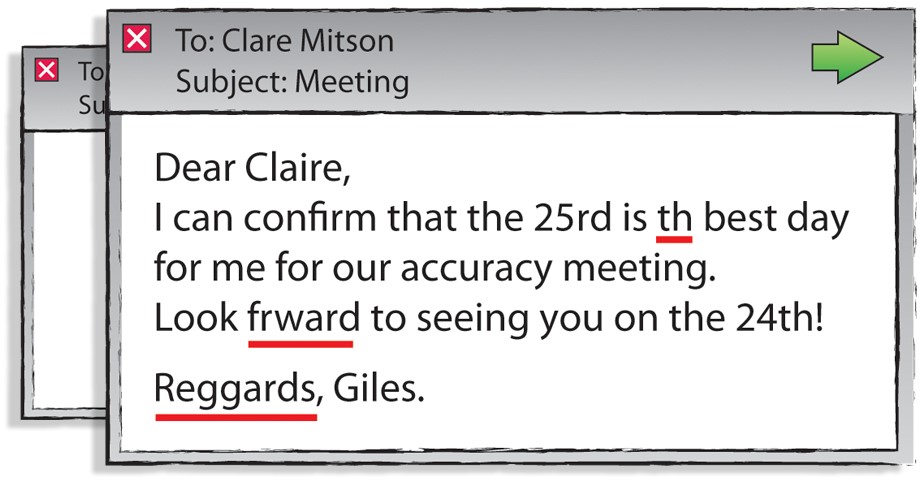Emails are an essential part of our day-to-day work and it’s important we avoid making mistakes to communicate effectively. But there are many ways emails can go wrong and cause unexpected problems and frustration. Have you ever sent a message and suddenly realised you’ve addressed it to the wrong person, or you’ve forgotten to attach some essential files? I’ve made both these mistakes - and more - with my own emails, but over time have trained myself how to stop making the same errors. To avoid spending time doing re-work and be more productive, here are three simple, useful tips you can use when sending your next message.
Mindset
When checking an email, you need a focussed mindset. We’re all guilty of briefly scanning over text, simply because of the pressures of work. The problem is that we often don’t properly check. Train yourself to read your own writing critically so you pick up every single mistake. Remind yourself ‘there is a mistake here somewhere, and I am going to find it’. If you are aware of the possibility of there being errors in your emails before you press ‘send’, you can prevent them from doing harm.
Methodology
It’s also important to have a methodology when you check an email. My own mental checklist consists of these three things:
Firstly, check the critical factors. These are essential details which, if inaccurate, could cause problems. Check your recipient’s name is exact, that you have the precise email address, and that any important facts or figures, like money for example, do not contain errors. Asking yourself simple questions, like ‘is the decimal point where it should be?’ and ‘have I transposed any numbers?’ will heighten your awareness of the possibility of error.
Secondly, check the operational necessities. If you wish to get an answer from your colleague or customer, write to them in a way that makes sense. Will they understand you and know how to reply? All too often, we send messages that are unnecessary or waste time, so ask yourself if the content is relevant or if the message needs sending at all.
Thirdly, check the professional touches. Your layout, language and presentation should represent who you are as a person. Check for spelling mistakes, as silly errors like this can damage your personal reputation and weaken your professional intelligence and authority. Also, remember to remove any email threads below, if they contain information you don’t wish your recipient to see.
Don’t just scan over your writing once. Use this mental checklist with the three sub-steps to become more attentive to detail and more mindful of how you present yourself. This process will only take a few extra minutes, and will save you time in the future otherwise spent correcting errors.
Message
Politeness is key when you write to your colleagues, boss, or customers, but you may sometimes be guilty of rambling or using unnecessarily embellished language. Keep your message clear and concise by demonstrating your points in as few words as possible. Read your message back and ask yourself ‘would I know what I needed to do if I received this?’ Make things straightforward for your recipient so it’s easier and quicker for them to reply.
Nobody intends to make mistakes in their work, but all too often errors slip through the net. This is simply because you may not be checking your work properly. So, try applying these tips with your next email. Check with the right mindset, attend to the critical factors, operational necessities and professional touches, and keep your message concise. With this attitude, you’ll get useful responses, maintain positive working relationships, and improve your personal effectiveness.
Alice Hubbard, Scott Bradbury Ltd | June 2018
About Accuracy Skills
Many of the ideas touched on in this short article are included in our one-day workshop Preventing Mistakes at Work. You can see details of this programme here.
Our core programmes Developing an Eye for Accuracy (about reducing data error) and Preventing Mistakes at Work (about reducing human error) enable participants to work accurately and efficiently, and are proven to reduce mistakes. They include learning about overcoming distractions, developing concentration skills and managing the causes of error-inducing stress.
www.accuracyprogramme.co.uk | @AccuracySkills | accuracy@scottbradbury.co.uk

Share to: LinkedIn Twitter Facebook
Accuracy Asides is the name of our accuracy blog
You get to hear about our latest accuracy course results, the real-life 'bloomers' which come to our attention and all the latest news and juicy gossip about errors! We share accuracy tips and advice too.
Other Recent Posts
Part-Time Positivity in the workplace
Our blog this month celebrates the ‘win-win’ of engaging part-time workers in our organisations.
Going Virtual and Getting Greener: Change in 2022
The last two years have been a time of change for everyone. As Scott Bradbury goes virtual and becomes greener, MD Catherine de Salvo explores the positive benefits of rethinking the way ahead in 2022.
Busyness: The state of having a great deal to do
In this month’s blog we discuss strategies for overcoming the too-busy mindset.
Let’s all focus on being productive instead of being busy.
Positive thinking for L&D and HR professionals
Practical positive thinking is about taking a step back and asking yourself what you can do, and what is possible. And it isn’t half energising! In this short article, Scott Bradbury Managing Director Catherine de Salvo applies some practical positive thinking to typical situations in Learning & Development.
How to be a successful training participant
The success of a training session depends in large part on the delivery – the expertise, personality, and facilitation skills of the trainer. But what about the participant? The preparation, contribution and reflection of the learner is vital.